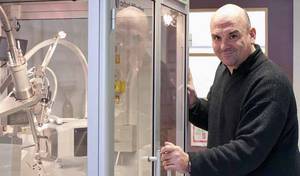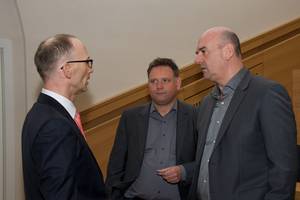The chemistry of moving pictures
UniCat has achieved exciting progress in elucidating the structure of active centers of catalysts - in the future, the Einstein Center for Catalysis will use new approaches and new partners to further explore their more difficult to identify dynamics
Since its foundation in 2007, the Cluster of Excellence UniCat has received a total of 55 million euros of DFG funding; the head institution TU Berlin alone received 35 million. Currently, 231 scientists are involved in UniCat research in total. In late October 2017, the TU Cluster of Excellence will run out, and something new will begin: the recently granted Einstein Center for Catalysis "EC2".
Prof. Matthias Driess, Speaker of both institutions, looks back contently on the past eight years: "With UniCat, we were able to show that it is possible to do research beyond the boundaries of chemistry, physics, and biology. Our Graduate School BIG-NSE also illustrates this in education," he states. "We were able to develop many projects far enough that they revealed unprecedented new insights into the nature of catalysts and brought forth widely noted publications, patents, and business collaborations.
One spin-off is 'BasCat', the UniCat-BASF joint-laboratory, which we founded together with BASF SE in 2012 in order to advance basic research in heterogeneous catalysis. This turbo-transfer in basic research is envied beyond the borders of Germany. UniCat has become a name brand. "From the beginning, the Cluster of Excellence has pursued the strategic goal to bring findings of basic research faster than ever into applied research, since much of basic research in retrospect reveals itself to be technologically viable. This applies to, for example, the oxidative coupling of methane to ethylene. "This requires very delicate tools of analysis and new catalysts, which we were able to develop jointly with BASF SE. This example shows that the separation of basic and applied research is often artificial," says Matthias Driess.
The UniCat Speaker is also particularly proud of the fact that by now, nearly all of UniCat's junior researchers have been called to appointments elsewhere. "In their new positions, these researchers act as ambassadors of our research while at the same time they contribute to the sustainability of an international network of the best heads in the areas of catalysis research".
In September 2015, The Einstein Foundation Berlin approved a grant for the new Einstein Center for Catalysis, which UniCat applied for and which will receive twelve million euros from January 2016 to 2022: EC2. The name reveals it all: "C to the second power"; one "C" stands for "catalysis research", the other stands for "catalysis of new scientific projects that will reach far beyond catalysis research". Research at the new center will be based on research results achieved at UniCat, but with new partners such as the Helmholtz-Zentrum Berlin (HZB) with its photon source BESSY II in Adlershof, or the nuclear magnetic resonance spectroscopy at the FMP in Berlin-Buch, the Leibniz-Institut für Molekulare Pharmakologie.
Matthias Driess explains why this is necessary: "UniCat has been able to clarify a great number of catalytically active centers in regard to their molecular structures with the aim to apply this knowledge to the development of resource-sustaining processes in light of the rapid dwindling of fossil fuels. Something new is happening at EC2. We are using a much more accomplished eye to observe how the structures of active centers at the atomic scale change at a high spatial and temporal resolution. We are investigating the structural and reactionary dynamics of active centers - a leap from 'freeze frame' to 'moving picture'. For this purpose we need new methods and thus also new partners".
And another issue is especially important to Matthias Driess: "We want to improve the conditions for spin-offs in the area of natural science and technology. UniCat and its successor EC2 have the best possible prerequisites because these projects will yield patents and additional chances for development. We have the Centre for Entrepreneurship that provides support and can cushion entrepreneurial risks, and finally, we are attractive enough to draw young, talented founders from outside of Berlin, as well. What we are lacking? Laboratory spaces! We have definitely reached the limits of our capacities. And this is where policy makers including Berlin business development politics should come in to help develop new solutions and to continue to offer a fruitful ground, because we are able to provide decisive and sustainable change, not just in science, but to the business location Berlin as well."
Patricia Pätzold, "TU intern" 12/2015; translated by Sabina Mollenhauer


